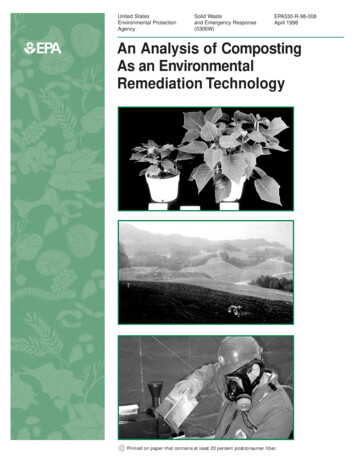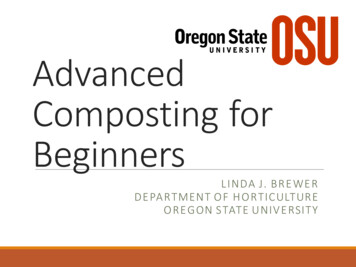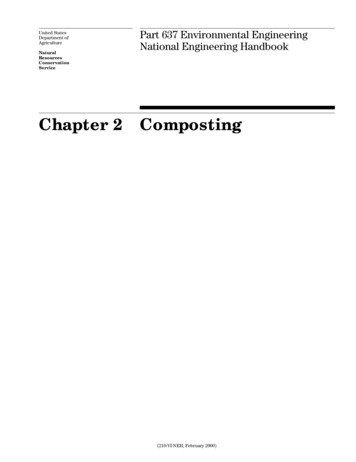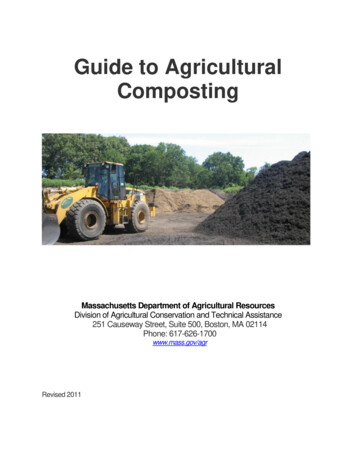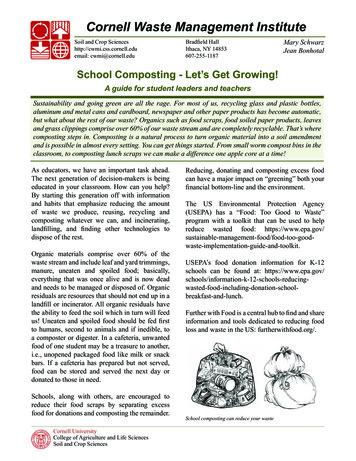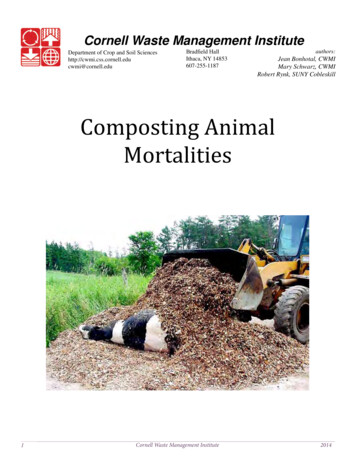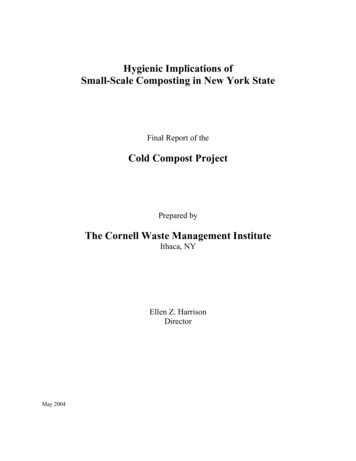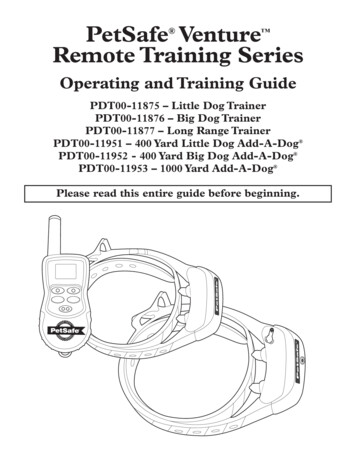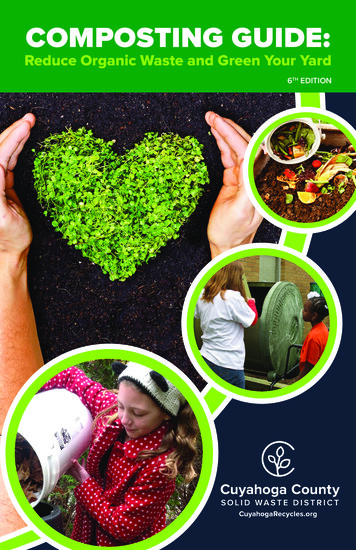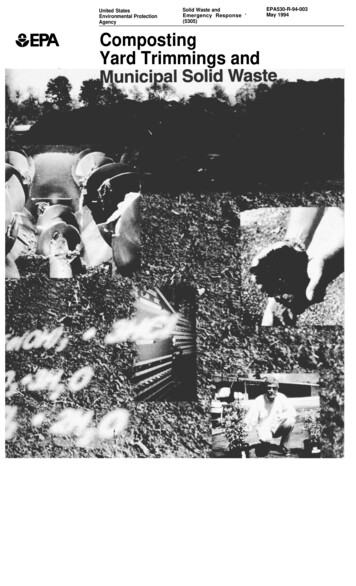
Transcription
United StatesEnvironmental ProtectionAgencySolid Waste andEmergency Response ‘(5305)CompostingYard Trimmings andEPA530-R-94-003May 1994
Composting of yardTrimmings andMunicipal solid WasteU.S. Environmental Protection AgencyOffice of Solid Waste and Emergency Response
AcknowledgmentsEPA would like to thank the following individuals for their contributions to the manual:Jan BeyeaCharlie CannonSteve DiddyDr. Melvin FinsteinDr. Charles HenryFrancine JoyalJack MacyRandy MonkDr. Aga RazviDr. Thomas RichardConnie SaulterDr. Wayne SmithRoberta WirthNational Audubon SocietySolid Waste Composting CouncilWashington State Department of EcologyRutgers UniversityUniversity of WashingtonFlorida Department of Environment RegulationMasshusettts Department of Environmental ProtectionComposting CouncilUniversity of WisconsinCornell UniversityNortheast Recycling CouncilUniversity of FloridaMinnesota Pollution Control AgencyIn addition, EPA thanks Wayne Koser of City Management Corporation and Steve Diddyfor their contributions to Appendix B: Composting Equipment.ii
Chapter OverviewChapter 1- PlanningDescribes the importance of planning and discusses someof the preliminary issues that decision-makers should examine before embarking on any type of composting program including waste characterization, operation plans,facility ownership and management, community involvement, vendors, and pilot programs.health risks including bioaerosols to workers at composting facilities and ways to minimize these risks.Chapter 2- Basic Composting PrinciplesProvides a brief scientific overview of the compostingproms. Discusses the physical, chemical, and biologicalfactors that influence composting including the type andnumber of microorganisms present, oxygen level, moisture content, temperature, nutrient levels, acidity/alkalinity, and particle size of the composting material.Chapter 8- Potential End UsersDescribes the potential end users of compost derived fromyard trimmings and MSW (agriculture, landscaping nurseries, silviculture, public agencies, and residents). Discusses how compost is currently utilized by these endusers as well as the potential for expanded use.Chapter 3-Collection MethodsDescribes options for collecting yard trimmings andmunicipal solid waste (MSW) along with the advantagesand disadvantages associated with each option. Highlightsthe critical role that source separation plays whencomposting MSWChapter 4- Processing Methods,Technologies, and Odor ControlDiscusses the three stages of composing (preprocessing,processing, and postprocessing). Introduces the types ofequipment associated with each stage, which are examinedin detail in Appendix B. Describes the methods currentlyused to compost yard trimmings and MSW in the UnitedStates, and provides a detailed discussion of odor control.Chapter 5- Facility Design and SitingDescribes factors to consider when siting and designing acomposting facility including location, site topographyand land requirements. Also discusses design considerations for preprocessing, processing and postprocessing areas; buffer zones; access and onsite roads; and site facilitiesand security.Chapter 6 - The composting Process:Environmental, Health, and Safety ConcernsFocuses on how to prevent or minimize the potential environmental impacts associated with composting including the potential for water pollution, air pollution,odorVector, fires, noise, and litter. Dicsusses the safety andChapter 7- State Legislatian and IncentivesPresents an overview of state legislation activity throughout the country. Also discusses state incentives to stimulate yard trimmings and MSW composting.Chapter 9- Product Quality and MarketingEmphasizes the importance of securing markets for thefinished compost product. Provides a detailed discussionof quality and safety concerns that could affect the marketability of compost. Also discusses key factors associatedwith marketing including pricing, distribution, educationand public relations, and program assessment.Chapter 10- Community InvolvementDiscusses the importance of developing strong local supportfor a composting operation. Also discusses ways to involveand educate the community throughout the planning siting,operation, and marketing phases of a composting program.Chapter 11- EconomicsIntroduces the economic and financial issues that must be examined when planning a composting facility Discusses capitalcost, operation and maintenance costs, and potential benefitsassociated with starting up and maintaining facility.Appendix A- Additional Sources ofInformation on CompostingLists publications related to composting as well as EPAcontacts.Appendix B - Composting EquipmentDescribes the cost, efficiency, and major advantages and disadvantages of the equipment commonly used at a composting facility.Appendix C- Glossary of Composting TermsDefines terms used throughout the guidebook.III
ContentsPageIntroduction . . . . . . . . . . . . . . . . . . . .1Composting as a Component of Integrated Solid Waste Management . . .1What Is Composting? . . . . . . . . . . . . . . . . .2Status of Composting Yard Trimmings and MSW in the United States3Chapter One - Planning11Goal Setting . . .11Waste Characterization11Operational Plans . .12Community Involvement12Facility Ownership and Management13Composting Vendors . . . . .14Pilot Programs . . . . . . .14Summary . . . . . . . .14Chapter Two - Basic composting Principles16Overview of the Composting Process . . .16The Role of Microorganisms . . . . .16Factors Influencing the Composting Process .17Oxygen . . . . . . . . .18Particle Size . . . . . . . .18Nutrient Levels and Balance . . .19Moisture . . . . . . . . .19Temperature . . . . . . . .19v
Table of ContentsChapter Two - Basic composting Principles (Continued)Acidity/Alklalinity(pH) . . . . . . . .19Summary . . . . . . . . . . . . . . .20Chapter Three - Collection Methods . . . . .21Factors in Yard Trimmings Collection . . . . . .21Public Drop-Off Sites for Yard Trimmings . .21Curbside Collection of Yard Trimmings . . .22Factors in MSW Collection . . . . . . . . . .28Source-Separated MSW . . . . . . . .28Commingled MSW . . . . . . . . .29Summary. . . . . . . . . . . . . . .30Chapter Four - Processing Methods, Technologies, and Odor ControlPreprocessing . . . . . . . . . . . . . . . .3131Sorting . . . . . . . . . . . . . . . . . .31Reducing the Particle Size of the FeedStock . . . . . . .37Treating Feedstock Materials to Optimize composting Conditions37Mixing . . . . . . . . . . . . . . . . . .39Processing . . . . . . . . . . . . . . . . . . . .40The composting Stage . . . . . . . . . . . . .40The Curing Stage . . . . . . . . . . . . . . .47Odor Control . . . . . . . . . . . . . . . . . . .47Process Control . . . . . . . . . . . . . . . .48Engineering Controls . . . . . . . . . . . . . .48Postprocessing . . . . . . . . . . . . . . . . . . .51Summary. . . . . . . . . . . . . . . . . . . .53Chapter Five - Facility Siting and Design . . . . . . . .56viSiting . . . . . . . . . . . . . . . . . . . . . . .56Location . . . . . . . . . . . . . . . . . . . .56Topography . . . . . . . . . . . . . . . . . . .59Land Area Requirements . . . . . . . . . . . . . . .59
Table of ContentsChapter Five - Facility Siting and Design (Continued)60Other Factors Affecting Siting DecisionsDesign . . . . . . . . .60Preprocessing Area . . .60Processing Area . . .60Postprocessing Area .62Buffer Zone . . . .63Access and Onsite Roads63Site Facilities and Security6464Summary . . . . . . .Chapter Six - The Composting Process: Environmental, Health, and Safety Concerns65Environmental Concerns During composting . . . . . . . . . . . . . . . .65Water Quality . . . . . . . . . . . . . . . . . . . .65Run-On/Ponding . . . . . . . . . . . . . . . . . . . . . .68Air Quality . . . . . . . . . . . . . . . . . . . . . . . .68Odor . . . . . . . . . . . . . . . . . . . . . . . . . .70Noise . . . . . . . . . . . . . . . . . . . . . . . . . .70Vectors . . . . . . . . . . . . . . . . . . . . . . . . .70Fires . . . . . . . . . . . . . . . . . . . . . . . . . .70Litter . . . . . . . . . . . . . . . . . . . . . . . .71Occupational Health and Safety Concerns During composting . . . . . . . . . .71Bioaerosols . . . . . . . . . . . . . . . . . . . . . . . .71Potentially Toxic Chemicals . . . . . . . . . . . . . . . . . . .72Noise Control . . . . . . . . . . . . . . . . . . . . . . .73Other. . . . . . . . . . . . . .73Worker Training . . . . . . . . . . . . . . . . . . . . . . . . .73Summary . . . . . . . . . . . . . . . . . . . . . . . . d.Incentives. . . . . . . . . . . . . .Composting Legislation Overview. . . . . . . . . . . . . . . . . . . . . . .PermitandSitingRequirements. . . . . . . . . . . . . . . . . . . . .767677vii
Table of ContentsChapter Seven - State legislation and Incentives (Continued)Facility Design and Operations Standards . . . . . . . . . .77Product Quality Criteria . . . . . . . . . . . . .78Bans Landfilling Combustion . . . . . . . . .79Recycling Goals . . . . . . . . . . . . . . .79Requirements for Local Governments to Implement composting79Requirements for State Agencies to Compost . . . . . .79Separation Requirement . . . . . . . . . . . . .79Yard Trimmnings and MSW composting Incentives . . . . . . .79State Encouragement and Local Authority to Implement Programs80. . . . . . . . . .80Procurement . . . . . . . .80Encouragement of Backyard Composting80Education Programs . .80Summary. . . . . . . .81Chapter Eight - Potential End Users87GrantsThe Benefits of Finished Compost87Agricultural Industry . . . . .87Landscaping Industry . . . .91Horticultural Industry . . . .92Silviculture. . . . . . .92Public Agencies . . . . . .93Residential Sector . . . . . .94. . . . . . . .96SummaryChapter Nine - Product Quality and Marketing . .98Product Quality . . . . . . . . . . . . .98Yard Trimmings Compost Quality . . . . .98MSW Compost Quality . . . . . . . .99Product Specifications . . . . . . . . . . .102.Vlll
Table of ContentsChapter Nine - Product Quality and Marketing (Continued)Product Testing . . . . . . . . 102Market Assessment . . . . . . .103Private vs. Community Marketing. 104Pricing . . . . . . . . 104Location/Distribution Issues . . 107Education and Public Relations . 108Updating the Market Assessment. 108Summary. . . . . . . . . .Chapter Ten - Community InvolvementPlanning the Composting Project . . . 108111111Community Involvement in Siting Decisions . . 112Public Participation in the Composting Project . . 113Community Education at the Marketing Phase . . 114Summary. . . . . . 114Chapter Eleven - Economics. 115Cost/Benefit Analysis . . . 115Capital Costs . . . . . 116Site Acquisition . . 116Site Preparation/Land Improvements . . 116Vehicle and Equipment Procurement . . 116Training . . . . . . . . . . . 117Permits. . . . . . . . . . . 117Operating and Maintenance (O&M) Costs . . . 117Collection Costs . . . . . . . . 117Labor Costs . . . . . . . . . . . 118Fuel, Parts, and Supplies . . . . . . . 118Outreach and Marketing Costs . . . . . 119Other Costs . . . . . . . . . . . 119ix
Table of ContentsChapter Eleven - Economics (Continued)Benefits from Composting . . . . . . . . . . . . . . . . . . . . . . . .119Avoided Costs . . . . . . . . . . . . . . . . . . . . . . . . .119Revenues . . . . . . . . . . . . . . . . . . . . . . . . . . .119Summary, . . . . . . . . . . . . . . . . . . . . . . . , . . . .120AppendixAppendixAppendixxA - Additional EPA Sources of Information on Composting . . . . . . . . 1 2 4BC-CompostingGlossaryEquipmentofCompost. . . . . . . . . . . . . . . . . . . 126Terms. . . . . . . . . . . . . . . . . 138
Introductioncomposting is a firm of recycling. Like other recycling effort, the composting of yard trimming and municipal solid waste can help decrease the amount of solid waste that must be sent to a landfill or combustor,thereby reducing disposal costs. At the same time, composting yields a valuable product that can be used byfarmers, landscapers, horticulturists, government agencies, and property owners as a soil amendment or mulch.The compost product improves the condition of soil reduces erosion, and help suppress plant diseases.The purpose of this manual is to aid decision-makers in planning, sitting, designing and operating compostingfacilities. It also will be useful to managers and operators of existing facilities, as well as to citizens, regulators,consult-anti, and vendors interested in the composting process. The manual discusses several approaches to comporting and outlines the circumstances in which each method should be consideredAS detailedin the manual a composting operation should be designed according to the need and resources of thecommunity. For example, a municipal composting effort can entail simply collecting yard trimmings on a seasonal basis and using a simple “windrow and turn” technology to produce the compost, or it can mean siting anddesigning a large facility that is capable of handing several tons of mixed municipal solid waste a dry.When considering any type of composting effort, however decision-makers must plan ahead to avoid potentialobstacles that could hinder the operation. The most common challenges are siting the facility ensuring that thefacility is properly designed mitigating and managing oak, controlling bioaerosols and investing adequatecapital to cover unforeseen costs. This manual helps decision-makers understand and prepare for these challangesso that they can develop a successful composting program in their communityIn 1990, Americans generated over 195 million tons ofmunicipal solid waste (MSW). The amount of waste generated annually in this country has more than doubled inthe past 30 years (EPA, 1992). While MSW generationrates have increased, however, the capacity to handle thesematerials has declined in many areas of the country. Manylandfills have closed because they are full. Others arechoosing to shut down rather than meet stringent newregulations governing their design and operation. In addition, new landfills and combustors are increasingly difficult to site. In conjunction with this growing gap indisposal capacity, tipping fees at solid waste managementfacilities are rising in many communities, and the trenddoes not appear to be changing. As communities searchfor safe and effective ways to manage MSW, compostingis becoming a more attractive management option.disposal costs avoided through composting and reducedexpenditures on soil amendments for municipal parks andlawns. In addition, composting can help communitiesmeet goals to recycle and divert substantial portions of theMSW stream from disposal. Many states are now settingambitious recycling goals for their jurisdictions. Becausecomposting can potentially handle up to 30 to 60 percentof a community’s MSW stream (EPA, 1993), it can play akey role in helping communities meet these goals. Finally,as a type of recycling, composting in many ways represents a more efficient and a safer use of resources thanlandfilling or combustion.In some communities, composting has proven to be moreeconomical than landfilling, combustion, or constructingnew landfills or combustors, especially when consideringEPA encourages communities to use a mix of management techniques (an approach called integrated solidwaste management) to handle their MSW stream since noComposting as a Component ofIntegrated Solid Waste Management1
Introductionsingle approach can meet the needs of all communities.Composting Food ScrapsEPA suggests a hierarchy of management methods for officials to consider when developing a solid waste management plan. Source reduction is the preferred managementEachyear, a Seattle-areaof grocery stores called Larry's Markets compost almost 500 tons of fruits, vegetables,food, and flowers that cant be sold andwoulf otherwise be throoption. Source reduction can bedefinedas thechaindesign,manufacture, purchase, or use of materials or products(including packages) to reduce their amount and toxicitybefore they enter the MSW stream. Recycling,includingorganic material is placed in specially marked dumpsters at Larry's five stores. Coffee residuals, called "chaff" are used to control moisture and reduce odors in the dumpscomposting is the next preferred management option.While lower on the hierarchy than source reduction andrecycling combustion (with energy recovery)and landfillOnce a week, Lawson's Disposal, a local hauler, picks up the materials and transports them to Iddings, Inc., a nearby topsoil company, for composting. The materialsing also are options to manage materials that cannot bereduced, reused, recycled, or composted. Combustionreduces the amount of nonrecyclable materialsthat mustare mixed with soil, yard trimmings, and ither organic materials to make a rich mixture that is sold for use as topsoil. The entire composting process takes 3 to 5be landfilled and offers the benefit of energy recovery.Landfillng is needed to manage certain types of nonreusable, nonrecyclable materials, as well as themonthsresiduesgenerto complete. Recently, Larry's has begun to buy back this misture for use on company landscaping projects, thereby "closing the recycling loop." As a resultated by composting and combustion.In any case, consideration of a composting programof thiscomposting project, Larry's Markets has reduced the amount of materials being landfilled by nearly 40 percent. This project has also significantlyshould be part of a community’s comprehensiveapproachto solid waste management. AS decision-makers evaluatetheir options for managing solid waste, many will look tocut Larry'sfordisposalcosts. Composting a ton of material costs Larry's 67, while running compactors, hauling mterial to local landfills, and paying landfill fees andcomposting as an attractive and viable optionhandling a portion of their MSW stream,What Is Composting?taxes costs 100 per ton. The difference between composting and landfilling for Larry's is a total saving of approximately 15,000 each year.Biological decomposition is a natural process that beganwith the first plants on earth and has been going on eversince. As vegetation falls to the ground, it SlOWly decays,providing minerals and nutrients needed for plants, animals, and microorganisms. Composting is often usedsynonymously with biological decomposition. As the termis used throughout this guidebook, however, compostingrefers to the controlled decomposition of organic (or carbon-containing) matter by microorganisms (mainly bacteria and fungi) into a stable humus material that is darkbrown or black and has an earthy smell. The process iscontrolled in that it is managed with the aim of accelerating decomposition, optimizing efficiency, and minimizingany potential environmental or nuisance problems thatcould develop.Composting programs can be designed to handle yardtrimmings (e.g., leaves, grass clippings, brush, and treeprunings) or the compostable portion of a mixed solidwaste stream (e.g., yard trimmings, food scraps, scrap paper products, and other decomposable organics). Thesematerials are the feedstock or “find” for the compostingprocess. Composting programs also have been designedfor sewage biosolids, agricultural residues and livestockmanures, food processing by-products, and forest industryby-products. Because these materials are not consideredpart of the MSW stream, however, they are not discussedat length in this guidebook. Some facilities compostMSW with sewage biosolids, which is a form of co-composting. Co-composting is not discussed in detail in thisguidebook.During the composting process, feedstock is placed in apile or windrow (an elongated pile) where decompositiontakes place. The rate of decomposition depends on thelevel of technology used as well as on such physical,chemical, and biological factors as microorganisms, oxygen levels, moisture content, and temperature. Composting works best when these factors are carefully monitoredand controlled.The end products of a well-run composting process are ahumus-like material, heat, water, and carbon dioxide.Compost is used primarily as a soil amendment or mulchby farmers, horticulturists, landscapers, nurseries, publicagencies, and residents to enhance the texture and appearance of soil, increase soil fertility, improve soil structureand aeration, increase the ability of the soil to retain waterand nutrients and moderate soil temperature, reduce erosion, and suppress weed growth and plant disease. FiguresI-1 and I-2 at the end of this introduction illustrate thesteps involved in composting yard trimmings and MSW.
IntroductionTrimmings MSW in theUnited StatesNationwide, nearly 35 million tons of yard trimmingswere generated in 1990, accounting for nearly 18 percentof the MSW stream (EPA, 1992). About 2,200 facilitiesfor the composting of yard trimmings were operating inthe United States in 1991 (Goldstein and Glenn, 1992).Approximately 12 percent or 4.2 million tons of the yardtrimmings generated in 1990 were composted by these facilities (This estimate however, does not include theamount of yard trimmings composted through “backyard” composting projects and other individual efforts.)(EPA, 1993).In 1990, the United States also generated over 16 milliontons of food scraps, 12 million tons of scrap wood, and 73million tons of paper waste, which together account for51 percent of the MSW stream (EPA, 1992). Althoughover 28 percent of all paper waste was recycled in 1988, anegligible amount of this material is currently composted(EPA, 1992). While composting of MSW has been practiced in other countries for many years, interest and commitment to MSW composting on a large scale is a recentdevelopment. As of 1992,21 full-scale MSW compostingfacilities were in operation in the United States (Goldsteinand Steuteville, 1992). Capacities of most of these facilities range from 10 to 500 tons of MSW feedstock per day.Minnesota leads the way with eight operational facilities;Florida has three, and Wisconsin maintains two MSWcomposting facilities (see Table I-1). Minnesota’s leadingposition is due, in part, to available state funds and technical assistance for MSW composting systems (Crawford,1990). A number of facilities also are in the planning orconstruction stages (see Table I-2). Table I-3 provides abrief comparison of the composting of yard trimmingsand MSW in reference to several operational and programparameters.AS thesenumbers indicate, composting is currently receiving a substantial amount of attention. Among otherfactors, this interest is due to regulatory and economicfactors. In recent years, a number of communities andstates have banned yard trimmings from disposal in landfills. As mentioned earlier, some states also have established ambitious landfill diversion goals, along withfinancial assistance programs that support alternativemanagement projects. Several states also have adoptedMSW compost regulations and more states are likely tofollow. Another important legislative development is thatseveral states currently require state agencies to purchaseand use compost if it is available and if it is equivalent inquality to other soil amendments (Crawford, 1990).Another indication of the headway being made incomposting is the increasing number of vendors marketing their composting systems to public offcials, haulers,and landfill operators (Goldstein and Glenn, 1992). Inaddition, many companies that are in the process ofconstructing new waste management facilities are planning to incorporate composting into their operations toreduce the amount of residuals that must be landfilled(Goldstein and Glenn, 1992). Additionally many communities and commercial establishments are now attempting to compost a larger portion of the MSW streamin an effort to reuse materials, rather than landfill or combust them. Several municipalities have established pilot orongoing programs to collect mixed MSW for composting.Others are conducting pilot projects for collecting sourceseparated food scraps. In addition, many restaurants andgrocers are composting leftover or unusable food scraps attheir operations.Introduction ResourcesCrawford, S. 1990, Solid waste/sludge composting International perspectives and U.S. opportunities. Proceedingsof the sixth international conference on solid waste management and secondary materials. Philadelphia, PA. December 4-7.Glenn, J. 1992. The state of garbage in America Part I.BioCycle. April, 33(4):46-55.Goldstein, N., and J. Glenn. 1992. Solid waste composting plants face the challenges. BioCycle. November,33(11):48-52.Goldstein, N., and R Steuteville. 1992. Solid waste composting in the United States. BioCycle. November,33(11):44-47.METRO. 1989. The art of composting A communityrecycling handbook. Portland, oregon MetropolitanService District.Taylor, A., and R. Kashmanian. 1989. Yard Waste Composting A Study of Eight Programs. EPA1530-SW-89038. Washington, DC: Office of Policy, Planning andEvaluation and Office of Solid Wrote and EmergencyResponse.U.S. Environmental Protection Agency (EPA). 1992. U.S.Environmental Protection Agency. Characterization ofMunicipal Solid Waste in the United States. EPA/530-R019. Washington, DC: Office of Solid Wrote and Emergency Response.U.S. Environmental Protection Agency (EPA). 1993. U.S.Environmental Protection Agency. Markets for compost.Washington, DC: Office of Solid Waste and EmergencyResponse and Office of Policy, Planning and Evaluation.
IntroductionTable 1-1.Summary of operating MSW plants.Plant NameCurrent Amount of ProprietaryYearMSW Composted Technolgy orstarted (tons/day)System(1)Lakeside, AZ199110-12New Castle, DE1984200-225Escambia County, FLPembroke Pines, Ft.Sumter County, FLBuena vista County, IA1991199119881991Coffeyville, KSMackinac Island, Ml19911992Fillmore County, MNMora, MN (EastCentral SWC)Lake of the woodsCounty, MNBennington County, MN1987199125019895198712St Cloud, MN198860Swift County, MNTruman, MN(Prairieland SWB)Wright County, MNSevierville, TN19901991125519921992165150 (design)Hidalgo County, TXFerndale, WAColumbia County, WIPortage, lddigesters200200504000/yr.BuhlerLundell (forprocessing)508 (inc. MSW, —Sludge, manure) (2)12DanecoOwnership/OperationJoint -4520Lundell (forprocessing)Eweson digesterw/Royer ag. bedOTVDBuhlerBedminsterBioconversionRoyer ag. icPrivate/PrivatePublic/PublicPublic/Public(1) This category is limited to compost system vendors and not other proptietary technologies/equipmentin use at these facilities.(2) Amount for Mackinac island indicates average daily flow due to park population during the summermonths,Source: Goldstien and Glenn, 1992.4
IntroductionTable 1-2.Nationwide listing of MSW composting facilities.FacilitySystemStatusARIZONA 1. Pinetop-LakesideOperationalTons/Day (Unless noted)Digester (Bedminster)12-14 (w/6 wet tpdsluge)ARKANSAS1. MadisonCALIFORNIA1. Chowchilia(Madera County)2. San Diego (City)3. Tulare County4. Ventura CountyPilotWindrowWindrow (enclosed)PlanningVendor negotiationA-SP (Daneco)Windrow or in-vesselProposal reviewProposal review for solidwaste managementCONNECTICUT1. Northeastern Conn. Proposal reviewRes. Rec. Auth.(Brooklyn)DELAWARE1. Del. Reclamation Project Operational(New Castle)FLORIDAvendor negotiation1.Cape CoralProposal review2. Charlotte CountyOperational3. Escambia CountyVendor negotiation4. Manatee CountyIn-Vessel/ EnclosedIn-vessel cycle)5. Monroe County Proposal review Pilot planning(1)Agitated bed (IPS)6. Palm Beach County(RDF, RDF rejects,mixed paper)Enc.aerated windrowOperational7. Pembroke Pines(Buhler)OperatiionalWindrow (Amerecycle)8.Sumter CountyIOWAWindrow (w/ Lundell1. Buenvista Countyprocessing line2.Cedar Rapidswet/dry separation)Consideration3. Council BluffsWindrow (w/ Lundell4. Harden County(w/Butler,Wrightprocessing linecounties)40(100-150 at full e)3,000 (total Stream)200200-225 (w/150-200 wettpd sludge)200400 (w/sludge)200 (400 design)1,000 (total Stream)75,600yr. (total Stream)550 (650 tionalWindrow50LOUISIANA1. Tri-Parrish SWC(St. Martin, IberiaLafayette)Consideration of pilot (Cocomposting)700 (total Stream)MAINE1. Bowdoinham2. Machias(Source sep. organics)(Source sep. OrangnicsA-SP1/month2,500 pop.MARYLANDConstructionIn-vessel (A-S-H) (2) 520(700 design)1. Baltimore(FERST Co.)Enc. A-SP (Rader Co.) 3402. Brandywine2.Brandywine20(300 design)3. Salisbury(wicomicoCty.Consideration of pilot In-Vessel (Seerdrum) (by American Materials Recyc.)Landfill)5
IntroductionTable 1-2.(Continued).FacilitySystemStatusTons/Day (Unless noted)Massachusetts1.Berkshire county(Southern)2.Franklin countyNantucket NorthamptonNorthfield6. Somersat7. Wrenthamconsideration (Market/odor15control studies needed)100siting(forsource sep. In-Vesselorgnics; sludgeEnc.-aerated 100Proposal reviewConsiderationProposed by Bennett Tunnel w/enc. windows 200Construction, Inc.Proposed by ERS700800(W/180 tpd sludge)Propose by ERSMichiganl. Mackinac IslandMINNESOTA1. Fillmore County2. Freeborn/Mowercounties3. Goodhue4. Kandiyohi County5. Lake of the woodCounty6. Mora (East Central SWC)7.Pennington County8.Rice County9. Rosemountl0. St.CloudOperationalOperationalPlanning(sourcesep. organics)Proposedby ng (w/ addtl.Counties)Planning (by Ceresfor RDF residualsMSW, other organics)Operationalby Recomp)1. SpringfieldNEW HAMPSHIRE1. Ashuelot ValleyRefuse Disp. Dist.2. HooksatNE
composting can potentially handle up to 30 to 60 percent of a community's MSW stream (EPA, 1993), it can play a key role in helping communities meet these goals. Finally, as a type of recycling, composting in many ways repre-sents a more efficient and a safer use of resources than landfilling or combustion. Composting as a Component of
